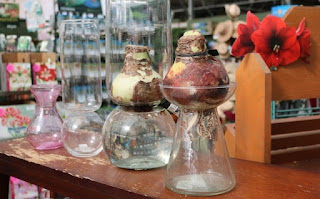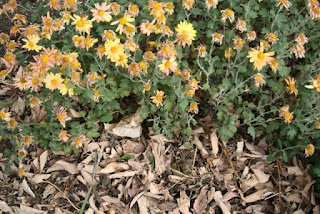Even though the temperature has cooled off the last few days, we're still going into the end November on a warm, dry note. Winter may be coming but right now it's important to see to a few garden chores. Things to do in the landscape on a late November day include cleaning up any left-over leaves, watering, adding mulch to the roses and perennials, planting garlic, spreading soil amendments on the vegetable garden and treating those persistent weeds you see popping up.
First of all, clean up any leaves that remain on the lawn. Left in place, leaves will smother the grass and create dead patches.
You can rake these leaves up or simply shred them with the lawn mower. Shredded bits of leaves will breakdown over the winter and improve the soil your lawn is growing in. Once the leaves are cleaned up, it's important to water. Watering now will benefit your lawn, trees, shrubs and perennials in two ways. Because it's been so dry and warm, trees, shrubs, lawns and perennials need hydration now. Long-term, everything in the garden will be better prepared for winter weather by watering at this time.
Soil needles,
stationary sprinklers or
hand-held nozzles will all work. Choose the one that fits your particular situation.
This is a good time to add mulch to your perennials and roses. Four or five inches of mulch will help preserve moisture and keep the ground stable through the winter. Choose from Gorilla Hair Mulch, Western Cedar Mulch or Soil Pep.
You may find a number of broad-leaf weeds greening up, such as Filaree. Filaree is a small, ground hugging plant, a member of the Geranium family that is taking advantage of the warm weather, just like a number of other weeds.
Treat them now with 20% acetic acid.
This strong vinegar will help control weeds, even at lower temperatures. Just be sure you keep it off plants you don't want to damage.
Apply tree wrap. Young trees are susceptible to sun scald during the winter. Applying tree wrap now will help prevent trunk damage.
Take advantage of the weather to add organic material to your vegetable beds. Two or three inches of Sheep, Peat and Compost, Canadian Peat Moss or Soil Pep now will set your garden up for a quick start next spring.
Plant garlic. The ground is still workable and garlic produces best when it's planted in the fall. There's still time for garlic to root before the ground gets cold.
While you're at it, see if there are any tulip bulbs left. They're on sale and it's okay to plant them now..
Finally, while you're out watering, weeding and planting, take time to enjoy any late blooming perennials and see if you can find any ladybugs enjoying the sun. www.theflowerbin.net
www.theflowerbin.net
Thursday, November 30, 2017
Thursday, November 23, 2017
Christmas Begins at The Flower Bin
A long-standing Flower Bin tradition continues this weekend as Christmas begins at The Flower Bin Holiday Open House, Friday, Saturday and Sunday, November 24, 25 and 26. There will live entertainment featuring Harpist Margot Krimmel and Jeffrey Rogers on the Hammered Dulcimer.
Margot will be performing Saturday and Sunday November 25 and 26 from 11 am to 1 pm.
Jeffery will perform Saturday and Sunday November 25 and 26 from 1:30 to 3:30.
Santa Claus will pay a special visit on Saturday, November 25th, from 11 am to 3 pm and Sunday November 26th from 1:30 pm to 3:30 pm.
Bring your camera for great family shots with Santa.
Enjoy holiday cookies and apple cider while you shop the best in holiday decorations including:
live and cut Christmas trees, wreaths, garland, ornaments and
featuring stunning Flower Bin grown Poinsettias. Start a tradition of your own by making the Christmas Open house at The Flower Bin a “Must Do” to kick off your holiday season. Thursday, November 16, 2017
Time to Plant Amaryllis
There’s nothing quite like an amaryllis blooming for the holidays. Best of all, amaryllis are easy to grow and their blooms last a long time.
Begin by selecting quality bulbs. Look for bulbs that are firm and dry and still have some of their natural papery covering. You’ll find amaryllis bulbs graded as small, medium and large. The larger the bulb size, the more stalks and blooms it will produce. Once you've chosen the bulbs you want to start, it's time to pick out a container. You can grow amaryllis in ceramic pots, clay pots or plastic pots. Whichever container you select needs to have good drainage.
It's also important to know that amaryllis like to be snug in their pot, so select a container that's about an inch or so larger than the bulb and is deep enough for the roots to grow.
Next, add damp potting soil to the bottom third of the pot. Place the bulb in the center of the pot and spread the roots out so they fan out from the center of the bulb.
Do the best you can with the roots. You're mainly trying to keep the roots from being bunched together under the bulb.
Fill in around the bulb with more damp potting soil. Leave the top third of the bulb uncovered. Water thoroughly and place the bulb in a warm, well-lit location. Once the flower stalk begins to appear, you can start feeding your bulb with a 20-20-20 fertilizer. After that, fertilize every two weeks and water frequently enough to keep the soil moist.
You can also grow amaryllis in stones and water, by using a forcing vase. Trim off dried roots to prevent them from decomposing in the water. This will help keep the water cleaner, longer. Add water to the container until it just touches the bottom of the bulb. Place the container in a bright, warm location. In about 6 weeks, your amaryllis should begin to bloom.
Once the blooms have faded, cut the flower stalk off near the top of the bulb.
Leave the foliage in place and continue to feed the bulb every couple of weeks. For colorful blooms throughout the holidays, plant amaryllis bulbs every three to four weeks, starting now. Thursday, November 9, 2017
Fall Rose Care Tips
Mid-November is the right time to get your roses ready for winter. Most of the winter damage to roses and perennials comes from temperature fluctuations, dry winds and lack of moisture. It's not uncommon for winter daytime temperatures to be surprisingly warm, followed by very cold nights.
Freezing night time temperatures followed by thawing out during the day can affect the soil around your roses and cause root and graft damage. There are three things to do now. First, make sure your roses are well hydrated, so give them a good drink of water. Plants with dry roots suffer more in cold temperatures than plants with wet roots.
Second, prune back canes to about 24" to 30". Prune to the outward bud, so that future growth is toward the outside, away from the center of the bush.
Make sure your pruners are sharp.
Dull pruners will crush the cane rather than cut it. Save any major pruning until spring. Clean up leaves and debris especially if you had problems with rust or black spot this season.
Third, mulch your roses to keep the ground cold and stable. Adding mulch at this time helps stabilize the soil temperature and prevent damage due to the freeze/thaw cycle. Mulching also helps prevent moisture loss. Roses that have been watered well and then mulched stand a better chance of surviving the winter than roses with dry roots. Choose a mulch that will stay in place through the winter. Cedar mulch and Gorilla Hair mulch are two good choices. Pile mulch 8" to 10" deep around the base of the rose.
Rose collars can also be used to help keep mulch in place.
Place the rose collar around the rose, fasten it and fill with a mulch.
Soil Pep is a good choice for filling rose collars. For climbing roses, follow the same procedure; clean up around the base of the rose, water well and mulch. Don't prune climbers at this time. You can secure the canes to their trellis or bundle the canes together and wrap them with burlap for protection.
A simple way to prevent winter wind damage is to use an anti-desiccant such as Wilt-Pruf. Applying Wilt-Pruf in the fall will help preserve moisture in your roses, through the winter. One more important winter task is to water your roses every 4-5 weeks. Pick a nice day above 45 and water your roses, trees and perennials thoroughly. Thursday, November 2, 2017
Put those fall leaves to work
Fall leaves are packed with organic matter and nutrients, so take advantage of this year's abundant supply to enrich your garden soils.
Good things happen when you add organic material to your garden soils. Clay soils become more workable, sandy soils retain water more effectively, earth worm populations go up, microbial activity increases and the health and balance of your soil improves. Continuously improving your garden soil is the key to healthier, more productive crops season after season.
An easy way to put fall leaves to work is to rake them up and scatter them across the surface of your garden, then fork them in a bit.
Another approach is to dig a shallow (5" to 6") trench, fill it with leaves and cover with dirt. Through the course of the winter, the leaves will break down.
Come spring, use a garden fork to work the composted leaves into your garden's soil. To speed up the composting process, put the catcher bag on your mower and mow the leaves instead of raking them. The resulting smaller pieces will breakdown faster in your garden.
Use leaves as a mulch around perennials. Mulching will help keep the ground stable and retain moisture. Fall leaves are a great source of carbon when added to your compost pile.
Leaves count as "browns" in making compost. A good ratio of browns and greens is about 4:1 browns (carbon) to greens (nitrogen). Adding leaves in thin (2" to 3") layers will help the compost pile stay warm and working during the winter.
Now's the time to put those beautiful fall leaves to work. You'll have a healthier, more productive garden next season.
Subscribe to:
Comments (Atom)

















































